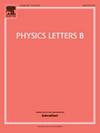Primordial black hole reformation in the early Universe
IF 4.3
2区 物理与天体物理
Q1 ASTRONOMY & ASTROPHYSICS
引用次数: 0
Abstract
Primordial black holes (PBH) can arise in a wide range of scenarios, from inflation to first-order phase transitions. Light PBHs, such as those produced during preheating, in bounce cosmologies, or at the GUT scale, could induce an early matter-dominated phase given a moderate initial abundance. During the early matter domination, the growth of initial PBH density perturbations can trigger collapse on horizon scales, producing much heavier PBHs. While the remaining original PBHs evaporate and reheat the Universe, these massive reformed PBHs survive for an extended period of time, producing potentially observable signatures at the present. We study this PBH reformation scenario and show that those reformed PBHs can emit significant quantities of γ-rays detectable by the next generation of experiments. The rapid reheating after matter domination generates a coincident stochastic gravitational wave background, which could be within the range of the upcoming CMB-S4 experiment. The PBH reformation scenario provides an intriguing possibility of decoupling the current PBH population and the initial formation mechanism from early Universe physics, while providing opportunities for observation through multi-messenger astronomy.
早期宇宙中原始黑洞的重构
原始黑洞(PBH)可以在各种情况下出现,从暴胀到一阶相变。轻pbh,如在预热期间产生的,在弹跳宇宙学中,或者在GUT尺度下,可以在初始丰度适中的情况下诱导早期物质主导阶段。在物质主导的早期,初始PBH密度扰动的增长可以触发视界尺度上的坍缩,产生更重的PBH。当剩余的原始pbh蒸发并重新加热宇宙时,这些巨大的重组pbh存活了很长一段时间,在目前产生了潜在的可观测特征。我们研究了这种PBH重组的场景,并表明这些重组的PBH可以释放出大量的γ射线,这些γ射线可以被下一代实验检测到。物质主导后的快速再加热产生了一个同步的随机引力波背景,这可能在即将到来的CMB-S4实验的范围内。PBH改革方案提供了将当前PBH种群与早期宇宙物理的初始形成机制解耦的有趣可能性,同时为通过多信使天文学进行观测提供了机会。
本文章由计算机程序翻译,如有差异,请以英文原文为准。
求助全文
约1分钟内获得全文
求助全文
来源期刊

Physics Letters B
物理-物理:综合
CiteScore
9.10
自引率
6.80%
发文量
647
审稿时长
3 months
期刊介绍:
Physics Letters B ensures the rapid publication of important new results in particle physics, nuclear physics and cosmology. Specialized editors are responsible for contributions in experimental nuclear physics, theoretical nuclear physics, experimental high-energy physics, theoretical high-energy physics, and astrophysics.
 求助内容:
求助内容: 应助结果提醒方式:
应助结果提醒方式:


